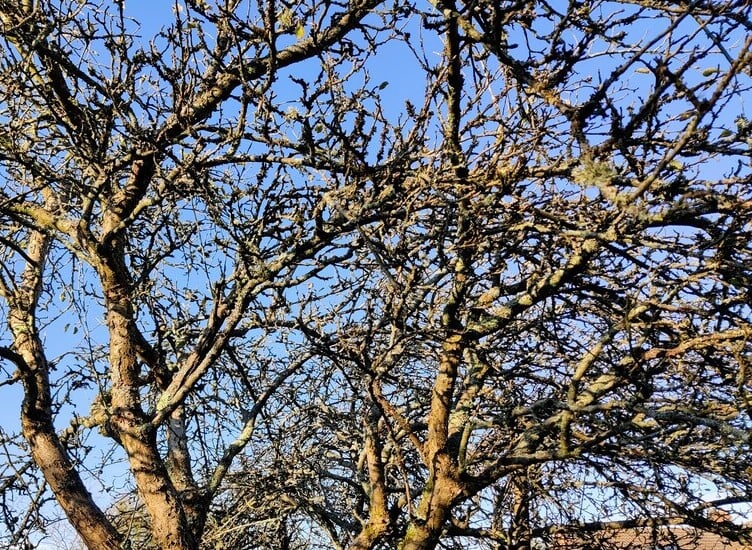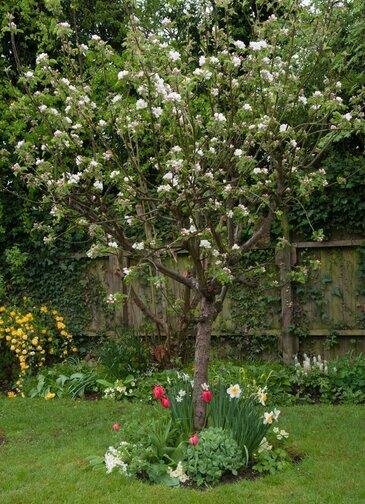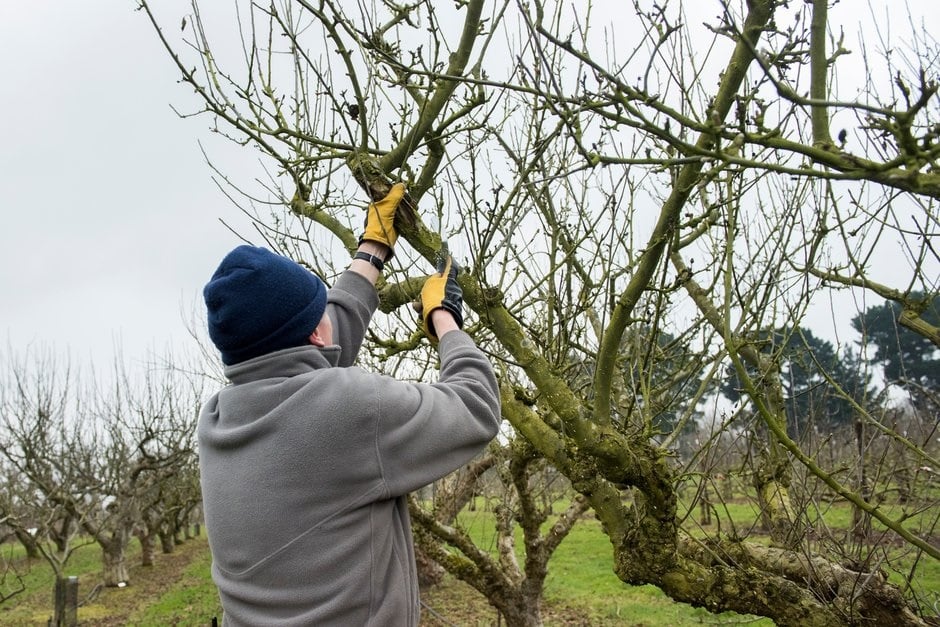Apples and pears: renovation pruning
With careful pruning, you can successfully transform old, neglected or overgrown trees into attractive garden features producing ample fruit. The work may need to be spread over several winters to reduce excessive re-growth and vigorous upright watershoots.

Quick facts
Timing: November to February
Difficulty: Moderate
Jump to
Before you start
Before you pick up your pruning saw, you need to decide whether your tree is healthy enough to save and what you’re aiming to achieve. Getting the timing right is crucial too. And if you need to refresh your pruning skills, check out our basic guide to pruning.
Choosing whether to renovate
As long as your tree has a healthy trunk and main branches that are producing new growth and fruiting, it is well worth saving. Just be sure to get larger trees checked by a qualified arborist to confirm they’re sound and pose no safety risk.
Old fruit trees are valuable on many levels – they’re great for biodiversity and also provide character and structure, making an attractive focal point. Even though an old tree may never provide large harvests, it should still give you a useful amount of delicious home-grown apples.
When and how to prune
Renovation pruning should be done between late autumn to late winter, when the tree is not in leaf. It will stimulate new growth in spring from the dormant buds in the older wood.
The aim is to reduce overcrowding of the crown and improve branch spacing, allowing light and air to reach all parts of the tree. A goblet-shaped structure of main branches with an open centre is the ultimate goal. Opening up the crown will improve fruit quality and reduce pests and diseases.
You can remove up to 25 per cent of the canopy in any one year. If more needs to be removed, save the rest for subsequent years. Although it’s tempting to do it all in one go, trees respond to excessive pruning by producing lots of upright vigorous watershoots that will simply overcrowd the crown again.
Once growth is under control, switch to winter pruning or consider winter regulated pruning if you want to prevent the tree getting gradually larger every year.

Apples and pears: winter pruning

Apples and pears: winter regulated pruning
How to renovate large overgrown trees
- Start by cutting out any dead, broken or diseased branches and stems. Look in particular for canker – a common problem in older trees
- Any lower branches that receive little light or are in the way can be removed entirely or pruned back to an upright shoot
- Remove larger branches growing into the centre of the crown. Smaller shoots can be left
- Look for crossing branches – these tend to rub together and get damaged. Retain the better positioned, outward-growing one, unless it’s badly damaged
- Prune overly long/tall branches to a strong, well-placed upward- and outward-growing side-branch lower down. To avoid dieback or excessive watershoots, the chosen side-branch you are pruning to should be at least one-third of the diameter of the branch you’re removing
- Step back regularly to assess the canopy from a distance, making sure you really want to remove particular branches
- Try to achieve well-spaced main branches, with 50–60cm (20–24in) between them (measured from halfway along the branch). Remove unwanted branches entirely or prune to a well-placed side-branch that’s one-third of the diameter of the branch you’re removing
- If the framework still looks crowded, with more than eight to ten main branches, remove the surplus limbs
Extra tips
- Where possible, avoid leaving bare stumps when pruning branches as this encourages watershoots or causes dieback
- Unless really necessary, avoid removing branches that are over 20cm (8in) in diameter. Large pruning wounds may not heal well, and removing large limbs can stress the tree
- Check your pile of pruned branches regularly. Don’t forget, if more than 25 per cent of the canopy needs to be removed, spread the pruning over several years
A neglected apple tree before renovation
1 The dense, crowded crown needs to be thinned out
2 Branches are crossing and rubbing
3 The low branches receive little light and get in the way
A neglected apple tree after two years of renovation
1 The crowded centre has been opened up. Note that the unwanted branches have been pruned out, rather than back to bare stumps
2 Well-spaced, outward-growing side-branches have been retained on the main limbs
3 The lower parts of the main branches are kept clear
How to renovate stunted, starved trees
These trees produce little new growth, but often have overcrowded, dense spur systems (stubby branches producing flowers and fruit). Reducing overcrowded branches and spurs will improve light penetration and air movement into the crown and encourage the growth of new branches. These will eventually replace the older, worn-out limbs.
Opening up the crown will also discourage pests and diseases. And it will deter moss and lichen from colonising the branches – often a sign of poor growth, but not the cause.
Carry out the pruning in late autumn or winter, as follows:
As always, start by removing dead, damaged or diseased wood
- Remove low-growing branches that receive little light
- Prune out branches growing into the centre of the crown, to open it up
- Thin out congested spurs (the stubby branches that produce flowers and fruit), aiming for 10–15cm (9–6in) between them
Next steps
- Remove any grass or other vegetation around the base of the trunk, creating a ‘tree circle’ with a radius of at least 90cm (3ft) – the larger the better. This will reduce competition from grass or other plants for water and nutrients, as well as keeping you from walking on the area when mowing, which might compact the soil and hinder root growth.
- In spring following renovation, apply fertiliser to the tree circle. Then mulch with a 5–8cm (2–3in) layer of organic matter, such as garden compost, well-rotted manure or a manure-based soil conditioner (widely sold in garden centres or DIY stores) and replenish annually.
- Poor growth is often due to overshadowing by larger trees or shrubs. If this is the case, prune back overhanging branches, where possible, to allow more light to reach the tree
Frequently asked questions
Apple and pear trees are usually grafted plants, with a rootstock that determines the tree’s growth rate and size. The cultivar that forms the upper part of the tree also has some bearing on overall size. Certain cultivars, such as ‘Bramley’s Seedling’, are inherently strong growing.
Traditionally, apple and pear trees were usually grafted onto vigorous rootstocks, so older trees often grow very large. Although you can reduce the height and improve the tree’s appearance, and maybe also its fruiting, you are unlikely to be able to maintain it as a small tree.
If the tree has completely outgrown the available space or if reliable fruiting is your priority, consider replacing the tree with a new one on a dwarfing rootstock. It will crop at an early age and be easier to manage.
How long will it take to renovate my old tree?
If your tree needs major renovation, this should be done in stages over two or three years. If you remove too much in one go, the tree will produce masses of upright, vigorous and unfruitful watershoots. It will then take a number of years to bring the watershoots under control, so there are no benefits to rushing the pruning.
Can I renovate the tree myself?
It will depend on the tree’s size. If the work involves removing large, heavy branches and/or working up a ladder, consider employing a qualified arborist.
How do I make sure the pruning cuts heal well?
Avoid leaving bare branch stumps. When removing a branch, the ideal location to make the cut is immediately outside the branch 'collar' (ie to retain the collar) – this is the bulge where the branch sprouts from the trunk or main stem. Take care not to prune branches back flush to the trunk or main stem, and don’t leave a snag or protruding stump, as healing is likely to be poor or dieback may occur. We no longer recommend using wound paint. See our guide to tree pruning for more details on removing branches cleanly.
Is it possible to identify the cultivar (variety) of my old apple tree?
Discovering your tree’s identity is a good idea – it may be an old cultivar that is rare or even lost from cultivation. Maintaining the genetic diversity and heritage of our fruit trees is important. You can bring fruit samples to RHS Fruit Naming Days at RHS gardens or send fruit to Brogdale Collections. RHS members can also use our postal identification service.
Some specialist fruit nurseries offer a grafting service, which may be useful if saving the original tree is not possible.
Problem solving
Apple tree problems: frequently asked questions
Get involved
The Royal Horticultural Society is the UK’s leading gardening charity. We aim to enrich everyone’s life through plants, and make the UK a greener and more beautiful place.